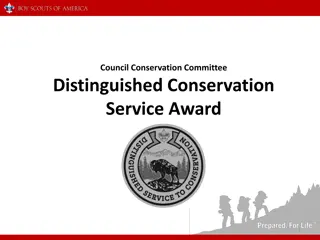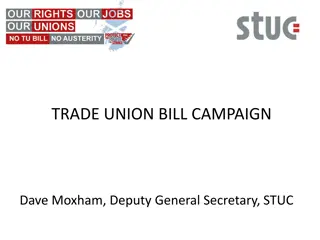Conservation Challenges and Opportunities in the 2018 Farm Bill
The 2018 Farm Bill presents a battleground where conservation, environmental protection, and agricultural interests collide. Key issues include changes in the Clean Water Act, pesticide use, CAFO operations, NEPA requirements, and potential impacts on conservation programs like the Conservation Stewardship Program and Forest Management Planning. The House and Senate versions of the bill clash over farm subsidies, conservation efforts, and work requirements for food stamp recipients, highlighting the complex and critical decisions faced in balancing agricultural production with conservation and environmental priorities.
Download Presentation

Please find below an Image/Link to download the presentation.
The content on the website is provided AS IS for your information and personal use only. It may not be sold, licensed, or shared on other websites without obtaining consent from the author. Download presentation by click this link. If you encounter any issues during the download, it is possible that the publisher has removed the file from their server.
E N D
Presentation Transcript
When Worlds Collide Conservation, Environment and the 2018 Farm Bill Laurie Peterson Office of the General Counsel, USDA
What Could Be Changing or Evolving?? Clean Water Act Farming use of pesticide and Concentrated Animal Feeding Operations (CAFO) NEPA Forest Service requirements for NEPA and waivers for logging industry, New Categorical Exclusions are possible Endangered Species Act Environmental Protection Agency s role could be changing. Conservation Stewardship Program promotes sustainability and stewardship in rural communities, does this go away? Forest Management Planning - Roadless Initiative, logging, prescriptive burning. We really don t know where this will end considering the outcome of the midterm elections but the Senate Bill would likely be signed by President Trump. 2 9/23/2024
2018 FarmBill and the Gulf Between The farm bill provides policies that support food safety, production agriculture, environmental quality, crop insurance, animal disease prevention, conservation, research, renewable energy, and new foreign market access. Historically, the Farm Bill has enjoyed widespread bipartisan support. However, legislation that has been forced to pass has been targeted as vehicles for poison pill, anti-environmental riders that put our lands, water, and wildlife at risk. There is an urgency to pass a Farm Bill when planning this, it was hopeful that the 2018 Farm Bill would be in place. It seems that the House is all about Agri production and Conservation and the Senate is all about Environmental issues. 3 9/23/2024
The GULF Most of the conflict between the House and Senate versions of the bill involves farm subsidies, conservation and work requirements for food stamp recipients. The House narrowly passed a Farm Bill version in June that would bolster those requirements and require most able-bodied recipients to spend 20 hours a week working, training for a job or volunteering. The Senate version does not change the current work requirements. The House bill s proposed changes to the Supplemental Nutrition Assistance Program. Those changes include expanded work requirements for a larger pool of adult able-bodied recipients is at issue in the Senate. Negotiators also differ on Title 1, which sets the terms for farm program subsidies. With the expiration of the 2014 farm bill, major programs such as crop insurance and SNAP, formerly known as the food stamp program, will continue because they are either permanently authorized in other laws or funded by appropriators. 4 9/23/2024
The Conservation Programs They are in there . . . But will they stay??? Since the New Deal programs of the 1930s, the federal government has used two general types of policy instruments in pursuit of conservation goals: (1) paying farmers to divert farmland into some form of conservation use such as grassland, forest, or wetlands and (2) paying farmers to install and maintain farming practices on working farmland that reduce erosion and runoff or protect wildlife habitat. Currently, five major programs implement one or both of these conservation strategies. Conservation Reserve Program (CRP) - pays farmers to convert cropland (and some grassland) to conservation uses Agricultural Conservation Easement Program (ACEP) Perpetual Easement Acquisition Program The EnvironmentalQuality Incentives Program (EQIP) partially subsidizes of the cost of installingapproved conservation structures or equipment on working farmland ConservationStewardship Program (CSP) pays farmers anannual fee to maintain a suite of approved conservation management practices on working farmland. Regional Conservation Partnership Program (RCPP), funds projects at a regional orwatershed scale that are undertaken by governmental or nonprofit entities. 5 9/23/2024
What about the environment?? Please just pass a bill and we will know
What I THINK will happen The Farm Bill will finally pass through the Senate Forests will have more management freedom, some see this as an erosion of EPA, NEPA, ESA, CWA protections of the environment. NRCS and FSA Conservation programs will still provide protection for our environment and income to our farmers. SNAP - will continue with a bolstered work requirement. The most of the 39 programs orphaned by the lapse of the 2014 Farm Bill will reemerge with some funding. 7 9/23/2024























